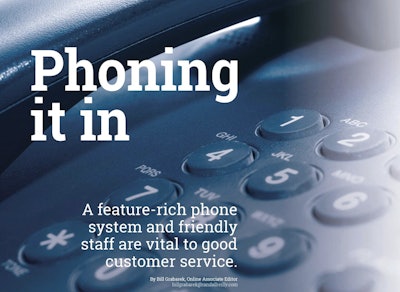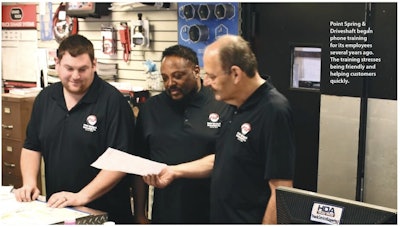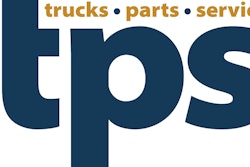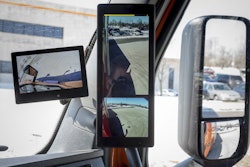
If you don’t have a staff tasked with answering calls all day, good customer service requires a good phone system, such as one that includes a clear menu system, voicemail and a function to reach your employees directly.
But that’s only part of the equation. Once customer calls are routed to employees, how are they answering the phone? Do they sound terse and impatient or do they sound eager to help and happy to have that customer’s business?
Maximizing accessibility
Royal Truck & Trailer has a master phone number with a menu enabling callers to reach each of its four locations and then connect with the various departments at those branches. In addition, many employees can be reached via their office extensions or mobile phones.
“If a customer ends up at wrong place somehow, we can transfer between branches and departments seamlessly and, if the power is out at one of our facilities, the phone system will automatically send those calls to a different branch so we don’t miss any calls,” says Adam Pigeon, chief operating officer, Royal Truck & Trailer.
Pigeon says the company implemented the VoIP phone system in 2010, when the economy was beginning to recover from the recession. “Ownership didn’t want to bring in staff to help with the phone calls, so they decided to improve the phone system,” he adds.
Point Spring & Driveshaft installed a PBX phone system at its main location in 2005 and by 2013 the system was rolled out to all of the company’s eight locations. The phone system includes menu-driven routing of calls as well as provides voicemail for all extensions, says Dennis McCloskey, network administrator, Purchasing Group, Point Spring & Driveshaft.
“This [phone system’s] purpose was two-fold: provide a quicker and easier method for our customers to reach the correct contact to help them as fast as possible and to remove the stress from administrative assistants,” he says.
For companies that have a phone menu system, or plan to implement one, they are not bound to the voices and messages that might come with the system. What’s more, it would be in companies’ best interest to personalize them, says Nancy Friedman, founder and president, The Telephone Doctor, a customer service training company, which provides training online, on-site and via webinars.
“You are not married to the robotic, monotone voice on the machine or the script that comes with the automated attendant. It’s not that it isn’t a professional voice, but it’s not a business-friendly voice and that’s critical,” Friedman says. “The machine is an outside employee. You need someone who works for you, so find the friendliest, happiest voice you can.”
Improved communication
Distributors and dealers with an effectively designed phone system can reap the benefits of better communication within the company as well as with their customers.
“Customers love that they don’t have to go through 10 people to find the right person and if they know who they’re trying to call, they have a direct extension they can enter,” says Pigeon. And should a customer end up with the wrong department or employee, he says “to get transferred to the right location takes a matter of seconds.”
Pigeon adds the company’s phone system helps him and his colleagues, too, because calls can be routed to their mobile phones. “It helps me because I answer everything on my cell phone; I don’t really use my landline all that often. I am able to answer more calls instead of having to call people back,” he says.
Not all customers like menu-driven phone systems, McCloskey admits, but for those who have embraced the technology, “they can program one phone number for all of Point Spring and use the menu to navigate to whichever branch or department they need to speak to. They can even reach our computerized faxing system from our main number,” he says.
The system’s voicemail feature helps employees, too. Citing himself as an example, McCloskey says he is on the phone up to four hours a day and if sales representatives call about a product order, they can leave a voicemail.
“The same applies in reverse. I might need to talk to a certain parts person or the branch manager and they might be tied up with a customer. They can glance at their phone, recognize it is my extension and let me go to voicemail and call back when things calm down,” he says.
The companies that have invested in advanced phone systems are glad they did because of the ability to be easily reached by their customers as well as reach fellow employees.
“The goal should be to get callers to the correct person to help with their needs as quickly and as efficiently as possible.” McCloskey says. “For example, if callers contact one of our branches and they have a question about their last billing statement, our sales team can easily transfer the callers straight to our accounts receivable department.”
Should a distributor or dealer decide to invest in a voicemail-driven phone network with menu prompts, McCloskey offers some advice.
A main menu obviously is required and the greeting should be concise, under a minute. After the main menu, there should be no more than two submenus, he says. “Our menu has one sub-level. The main greeting instructs users to ‘Press 1 for parts and service.’ And the second level tells them which number to press to get to each of our branches,” McCloskey says.
Ian Coburn agrees menus cannot be too complicated. Coburn is president, director of learning, at GPA Training, which provides e-training, in-person training and gaps analysis consulting. He also is a public speaker and the author of the book, “The Customer is Never Right.”
“Lots of callers won’t go past two menus and, instead, will hang up and call your competition,” Coburn says. “And offer the option to press ‘0’ at any time in the menu process for customers to either reach a person or leave a message.”
Importance of training
Just as important as a good phone system are the employees answering the calls. Training is essential to ensure they know how to operate the phone system and that they are greeting customers properly.
“Customers don’t come to you for parts or service; they come to you for expertise, sometimes without even realizing it. Without customer service, you won’t get the chance to provide that expertise,” Coburn says.

Friedman says whoever answers the phone needs to have a greeting that identifies themselves and the department. “‘Hi, thanks for calling the parts department. This is Bob,”’ she says. “Picking it up with, ‘Parts,’ is cold and rude.”
Pigeon says Royal Truck & Trailer currently does not train its employees on how to answer the phones, but it’s something the company is looking into.
“We want to make sure the professionalism is there and that each employee is presenting Royal in the light that the owners want it to be presented. Also, if customers reach the wrong number, we want to make sure employees get them to the correct person on the next transfer,” he says.
Although misrouted calls can be caused by employee error, customers also can accidentally press the wrong button on a menu system. When this occurs, there is a proper way to handle it, advises Friedman.
“The worst thing you can say is, ‘You have the wrong department.’ You’re accusing the customer. The better way is, ‘Oh, you’ve reached parts; you need service; let me transfer you. By the way, it’s extension 101 if we get disconnected.’ The more information you can give to someone who is getting bounced around, the better off the company will be,” she says.
Friedman offers some additional tips for training staff on how to answer the phone after the system has routed customers’ calls to them. Don’t be too busy to be nice, one-word answers can be perceived as discourteous; putting someone on hold without asking is very frustrating to the customer; “and, count on it, customers can hear a smile,” she says.
Coburn says staff should be trained in all aspects of customer service, including answering the phone. “Define customer service to ensure everyone across the company is on the same page and moving in the same direction,” he says.
“Make sure everyone understands ‘customer friendly’ means solving the customer’s problem. The goal when answering the phone isn’t just being polite. Yes, be polite, but the goal is to control the conversation,” he says.
Controlling the conversation by asking questions enables staff to identify and serve the true needs of the customer, he says, which means teaching techniques for controlling the conversation should be part of the training.
Coburn also advises companies to own their training, meaning if they use an outside party, make sure they can buy the rights for their permanent use.
“This enables you to have consistency in the training by accessing it whenever you wish,” he says. Being able to revisit the training materials prevents the lessons from “not sticking” or “fading away,” he says, adding it’s also needed for new hires.
“When a customer calls, they need something. If the need is there and you have the answer, you have a sale and you make money,” Friedman says. “Customer service is often overlooked in this industry. I get many calls that say: ‘Hey I need your help,’” she says. “More business is lost due to poor customer service than poor product or services.”











